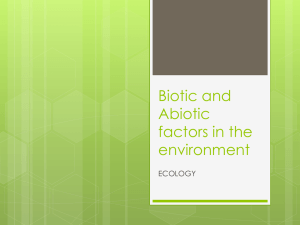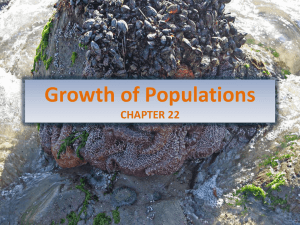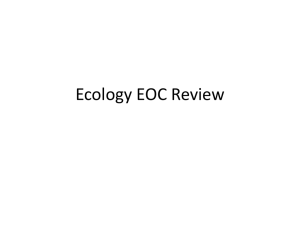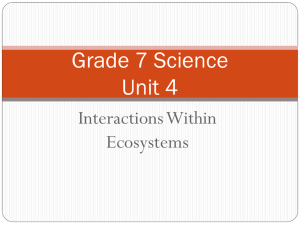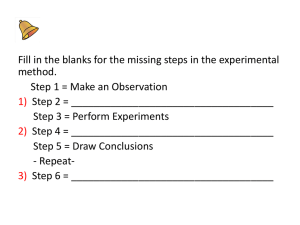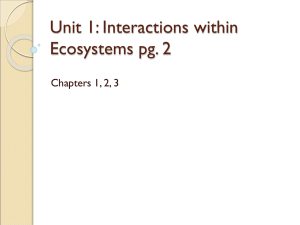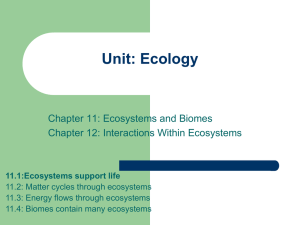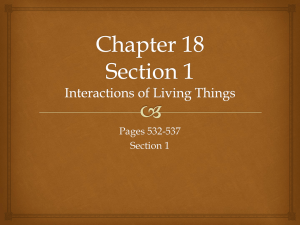Abiotic=non-living things. Eg: Sunlight, minerals, air, soil, water, etc.
advertisement
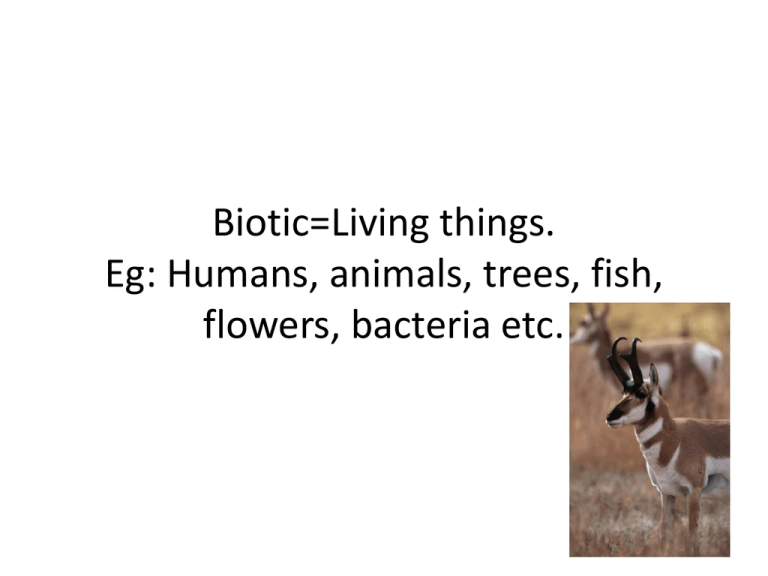
Biotic=Living things. Eg: Humans, animals, trees, fish, flowers, bacteria etc. Abiotic=non-living things. Eg: Sunlight, minerals, air, soil, water, etc. Example Biotic: •Other Pronghorns •Insects •Bacteria •Grasses •Other mammals •predators Abiotic: •Water •Air •Soil •Temperat ure Pronghorn Environment: Everything which affects an organism throughout its life, and everything which the organism effects. Individual Organisms Populations Ecologists: Scientists who study the interactions of organisms with one another and their environment. Communities Ecosystems Individual organisms: Want to learn how the abiotic environment in which an individual lives affects it behavior or physical features. The Banff spring snails Alpine plant Populations • Species: organisms that breed with one another to produce fertile offspring's • Population: group of same species living at a specific area at the same time Describes the changes in site as time passes; Example: Lilies in Bugaboo Mountains • How the population; – Increases – Decreases – Remains consistant during a period of time Also study • Rate at which a population changes in size • Factors that determine relative numbers of males or females (or young and old) Example: The Study of Changes in Population of Pikas Pikas • Related to rabbits and live in alpine regions • They forge on grasses and flowers that they hoard in haystacks in their tunnels for winter • Vulnerable to temperature changes: • Population decrease – Global warming -> Rising temperatures -> changes in vegetation -> less to eat – Lack of snow -> reduces cover on their rock tunnel homes – Lack of snow -> not enough to provide insulative blanket • Populations of different species are rarely isolated; instead they interact with one another • Community: all individuals of interacting populations in given area – Study interactions among populations Example: Why some communities made up of many species compared to a community of few species Saskatchewan • Compared number of species in birds within section of intact forest and forest fragments • Found: – Species preferred interior, common in intact forest – Species preferred “edges”, common in forest fragments Interactions that influence structure of community • Competition between same species in different populations • Relationship between predators and prey population • Abiotic factors that have a strong influence on which and how many species live in a community; – How much moisture is present – Number of hours of sunlight Examples • Bird species competing for nesting habitat • Droughts change composition of plant species growing in area Communities • Dynamic • Change as abiotic conditions in environment change • As population of one organism fluctuates, effects the population level of other organisms that they can consume or be consumed by • Modify community by interaction to become suitable • Gradually take over and form new community Example: • After a fire in forest, open area is created – First organisms to establish themselves are members of species that do well in disturbed habitats • Create: – Shade – Alter soil – Make habitat less suitable for species like themselves and more suitable for other species New habitats • Become available after: – – – – Rockslides Floods Volcanic eruption Glacier recedes • Example: Century after ice has melted lush meadow grows evolves into forest Ecosystems • An Ecosystem is a community of populations, together with the abiotic factors that surround and affect it. It includes all of the non-living parts of the environment in a particular area and all the living organisms, as well as the interactions among them. • Ecosystems can be any size. There are smaller ecosystems within larger ecosystems. Example • This lichen covered boulder could be considered an ecosystem within an ecosystem. It contains a community of living things together with abiotic components such as air, water and minerals. This ecosystem interacts with and is a component of a larger ecosystem. The Earth’s Biosphere • All the ecosystems in the world and their interactions make up the biosphere. The biosphere is thought of as the largest possible ecosystem. It consists of all parts of Earth which are inhabitable by some type of life and extends several kilometers into the atmosphere and several meters into the soil. The Earth’s Biosphere • Each species has its own “place” in the biosphere. For example mountain goats live in specific places in Canada. They do not live across the entire country. • The distribution of species is related to the ways the biotic and abiotic components of an environment affect individual organisms and their ability to survive. MOUNTAIN LION Summary • Biotic and abiotic components are part of any environment. • The interactions between organisms is divided into four parts by ecologists—individual organism, populations, communities and ecosystems. • Ecologists usually specialize and focus on one level of the environment eg. A community ecologist. • The research of an individual organism includes the effect of the abiotic elements of its environment on physical features or behavior. Summary • The study of a population includes every member of the same species inhabiting a specific area plus their interactions with and the effects of the abiotic elements of their environment. • The study of a community includes all individuals of all interacting populations in a specific area. • The study of an ecosystem includes all abiotic and biotic elements and their interactions. • Usually communities change over time because the abiotic elements change over a time period. Changing abiotic elements affect organism and their interactions on all levels.

